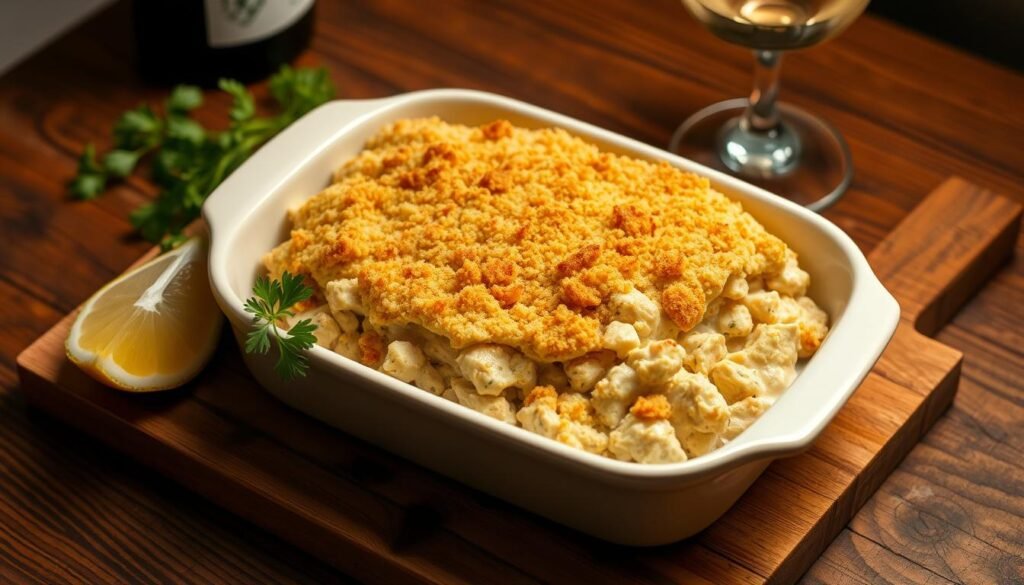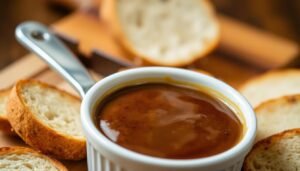I still remember my grandmother’s kitchen. It was filled with the savory aroma of a classic tuna casserole recipe. This dish brought our family together. It’s a staple in American cuisine, loved for its simplicity and flavor.
Tuna casserole is more than a meal; it’s a nostalgic reminder of home-cooked meals and warm memories. In this article, I’ll share my take on this beloved casserole. I’ll highlight its ease of preparation and the delightful taste that makes it a favorite among many.
Key Takeaways
- Easy-to-follow steps for making a delicious tuna casserole
- Tips for customizing the recipe to suit your taste
- The nutritional benefits of including tuna in your meal
- Variations of the classic recipe for added flavor
- How to make this comforting dish a part of your family’s traditions
Understanding Tuna Casserole: A Comfort Food Classic
Tuna casserole is loved for its simplicity and warmth. It’s a comfort food that brings back memories. Its history spans many years.
What Makes Tuna Casserole So Special?
Tuna casserole is special because it’s easy to make and tastes great. You can use simple ingredients found in most kitchens. Its flexibility and ease of making have made it a favorite for many.
- Easy to prepare
- Affordable ingredients
- Customizable
The History Behind Tuna Casserole
Tuna casserole started in the mid-20th century. It became popular because of canned tuna and easy cooking. For a classic recipe, check out this old-fashioned tuna casserole recipe. It was made even more popular with cream of mushroom soup and pasta.
Regional Variations of Tuna Casserole
Even though tuna casserole is the same everywhere, places have their own twists. Some common changes include:
- Adding local ingredients like peas or bell peppers
- Trying different pasta or sauces
- Using various cheeses for more flavor
These changes show how tuna casserole can be made to fit any taste.
Key Ingredients for a Delicious Tuna Casserole
The secret to a mouth-watering tuna casserole starts with the best ingredients. Choosing the right ingredients is key to the dish’s flavor and texture.
Essential Pantry Staples
A well-stocked pantry is crucial for a great tuna casserole. You’ll need canned tuna, pasta, canned soup, and breadcrumbs. These are the core ingredients and are found in most supermarkets.
Here’s a breakdown of the essential pantry staples and their roles:
| Ingredient | Role in the Recipe |
|---|---|
| Canned Tuna | Provides protein and flavor |
| Pasta | Serves as the base of the casserole |
| Canned Soup | Adds creaminess and moisture |
| Breadcrumbs | Creates a crunchy topping |
Choosing the Right Tuna
Choosing the right tuna is vital for a delicious casserole. I suggest using high-quality canned tuna that’s rich in protein and has a firm texture. Look for “skipjack” or “albacore” tuna for the best taste.
Creamy Sauces and Their Contributions
Creamy sauces are key to a tuna casserole, adding moisture and flavor. You can use canned cream of mushroom soup or make your own sauce. The sauce binds the ingredients and adds a rich flavor.
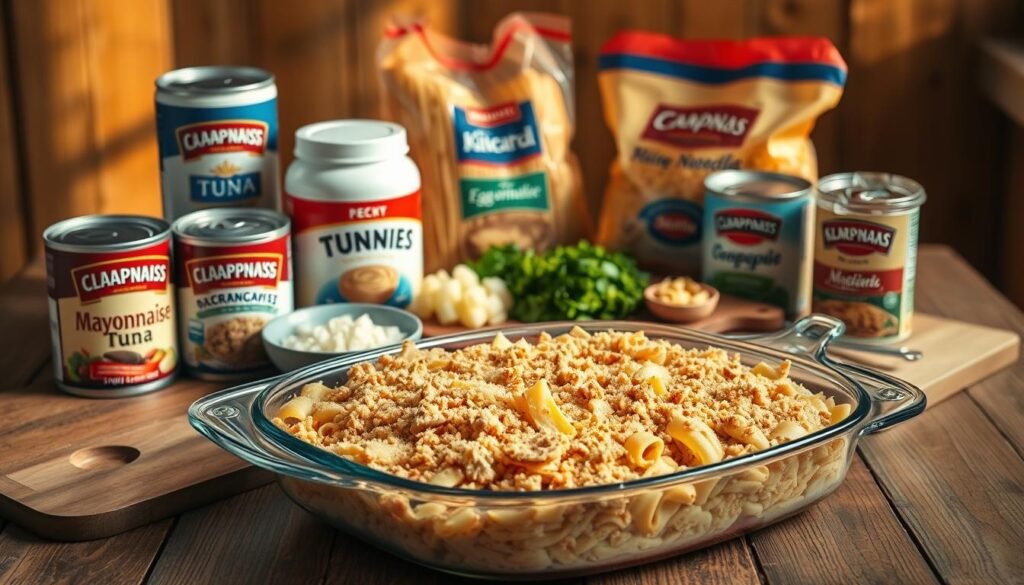
Step-by-Step Tuna Casserole Recipe
Let’s dive into making a tasty Tuna Casserole. This classic dish is easy to make and needs just a few ingredients.
Preparation: What You’ll Need
Before cooking, gather all the ingredients. For a basic Tuna Casserole, you’ll need canned tuna, pasta (like macaroni or egg noodles), canned cream of mushroom soup, milk, shredded cheddar cheese, and french-fried onions.
Essential Ingredients:
- Canned tuna
- Pasta (macaroni or egg noodles)
- Canned cream of mushroom soup
- Milk
- Shredded cheddar cheese
- French-fried onions
Cooking Instructions to Follow
To cook Tuna Casserole, start by preheating your oven to 350°F (175°C). Cook the pasta until it’s al dente, then drain and set it aside.
Then, mix the canned tuna, cream of mushroom soup, and milk in a large bowl. Add the cooked pasta and shredded cheddar cheese. Stir until everything is well mixed.
Put the mixture in a baking dish. Sprinkle more shredded cheese and french-fried onions on top.
Bake for 25-30 minutes. The top should be golden brown, and the casserole should be hot through.
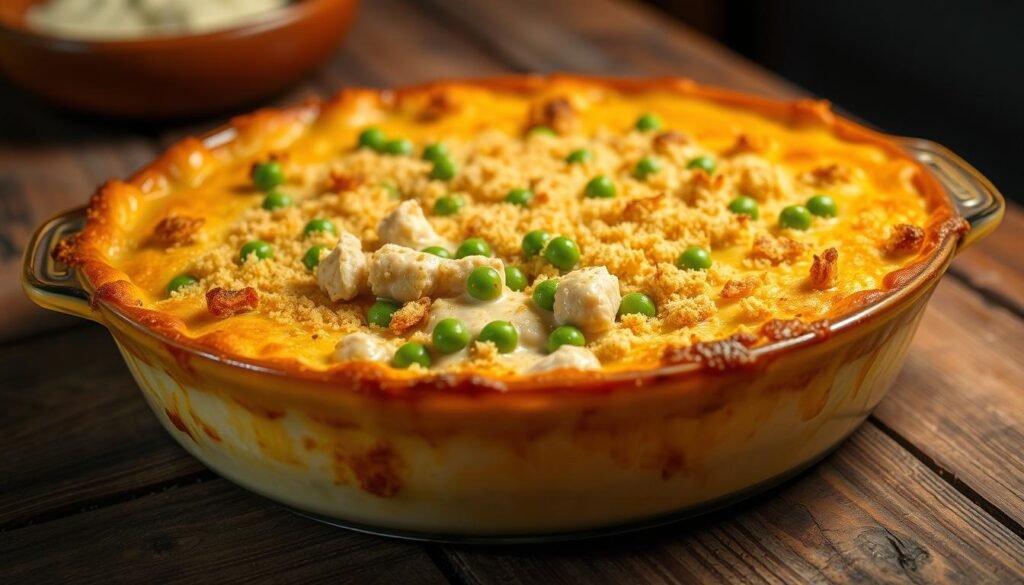
By following these steps, you can make a delicious Tuna Casserole. It’s sure to be a hit with your family.
Creative Twists on the Traditional Recipe
The classic tuna casserole recipe is a blank canvas for your creativity. You can make it better by adding new ingredients or trying different cooking methods. This turns a comfort food into something special.
Vegetable Additions for Extra Flavor
Adding vegetables can make tuna casserole taste better and be healthier. Try adding spinach, mushrooms, or bell peppers. For instance, sautéed mushrooms bring a rich flavor, while spinach adds nutrients.
As Julia Child said, “The only time to eat diet food is while you’re waiting for the steak to cook.” Let’s look at some veggies that can make your tuna casserole even tastier.
- Sautéed spinach with garlic
- Mushrooms cooked with thyme
- Roasted bell peppers
Cheese Alternatives for Every Palate
The cheese in tuna casserole greatly affects its taste. While cheddar is common, you can try Parmesan, Gruyère, or even a dairy-free option. For a lighter taste, mixing cheeses can be a great choice.
For more ideas, check out leftover chicken recipes for inspiration.
“The discovery of a new dish does more for human happiness than the discovery of a new star.” – Jean Anthelme Brillat-Savarin
Using Different Pasta Types
Choosing different pasta can change the texture and taste of tuna casserole. While macaroni is traditional, penne, fusilli, or farfalle can make it look and feel different. Trying various pasta shapes can lead to your new favorite dish.
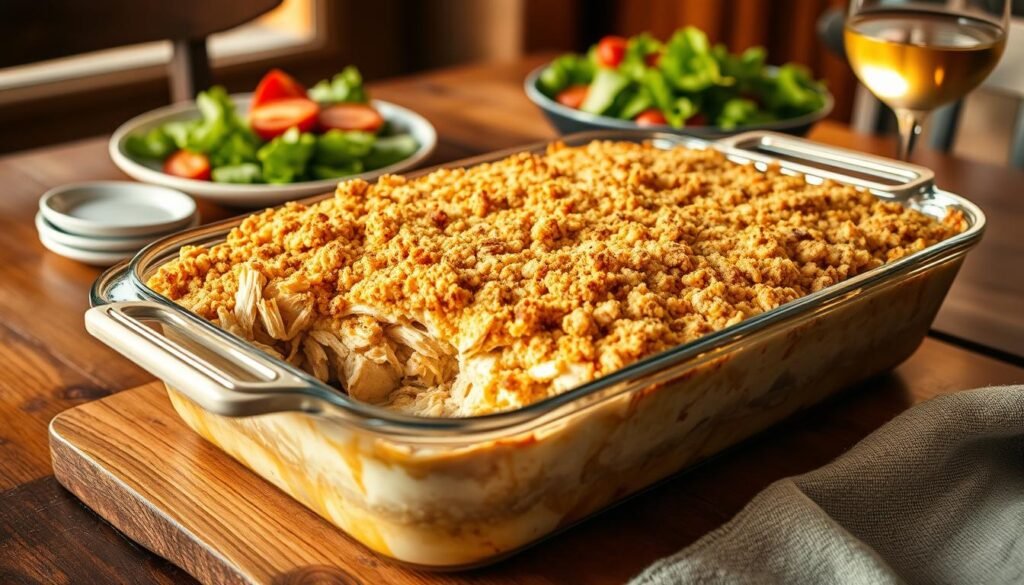
By trying these creative ideas, you can keep your tuna casserole recipes exciting. Whether it’s adding new veggies, experimenting with cheeses, or trying different pasta, there’s always something new to try.
Tips for the Perfect Tuna Casserole
To make a great tuna casserole, knowing the common mistakes is key. Whether you’re new to cooking or experienced, a few tips can greatly improve your dish. They ensure your tuna casserole is both tasty and fulfilling.
How to Avoid Common Mistakes
One big mistake is overcooking or undercooking the pasta. This can make the casserole unpleasant to eat. Cook the pasta al dente. It will cook a bit more when mixed with hot sauce and baked.
Not draining the tuna well is another mistake. This can make the casserole soggy. Always drain the liquid from the canned tuna before mixing it with other ingredients.
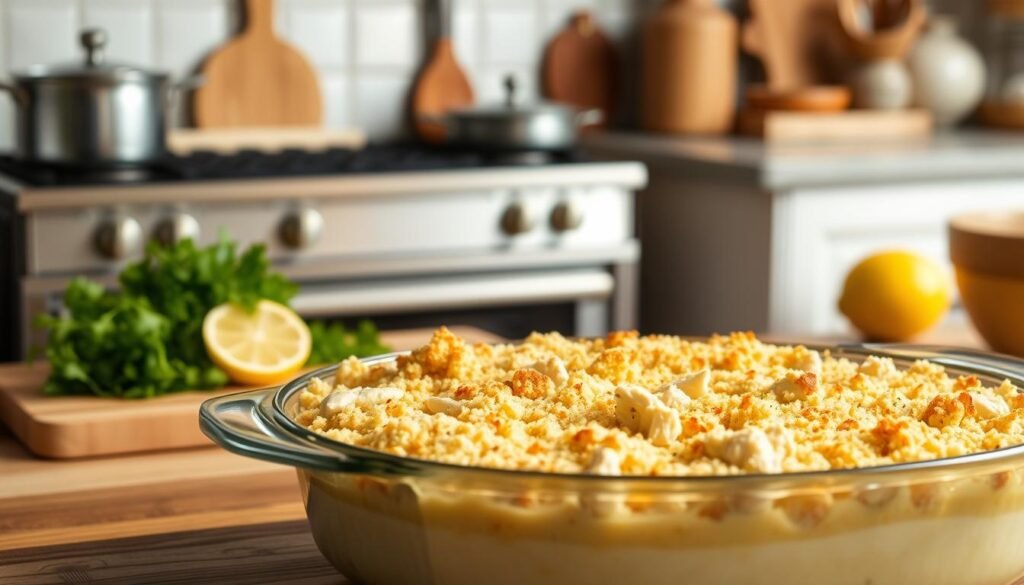
Achieving the Right Consistency
The casserole’s consistency is key to its appeal. It should be creamy but not too runny. It should also be firm enough to hold its shape when served.
To get the right consistency, balance the sauce with pasta and other ingredients. If it’s too dry, add a bit more cream or milk. If it’s too wet, add more pasta or breadcrumbs to soak up the excess.
| Ingredient | Role in Consistency | Tip for Adjustment |
|---|---|---|
| Pasta | Base of the casserole | Cook al dente to prevent overcooking |
| Cream/Milk | Adds creaminess | Add gradually to achieve desired consistency |
| Breadcrumbs | Top layer texture | Sprinkle evenly for a crunchy top |
By following these tips and avoiding common mistakes, you can make a tuna casserole that’s delicious and looks great. The secret is to balance flavors and textures and get the consistency just right.
Making Tuna Casserole Healthier
Tuna Casserole can be a nutritious meal when made with better ingredients. We need to look at the ingredients and cooking methods used in the traditional recipe.
Substituting Lighter Ingredients
To make Tuna Casserole healthier, we can use lighter ingredients. Choosing low-fat dairy products instead of full-fat ones cuts down calories. Also, using canned tuna in water instead of oil reduces fat.
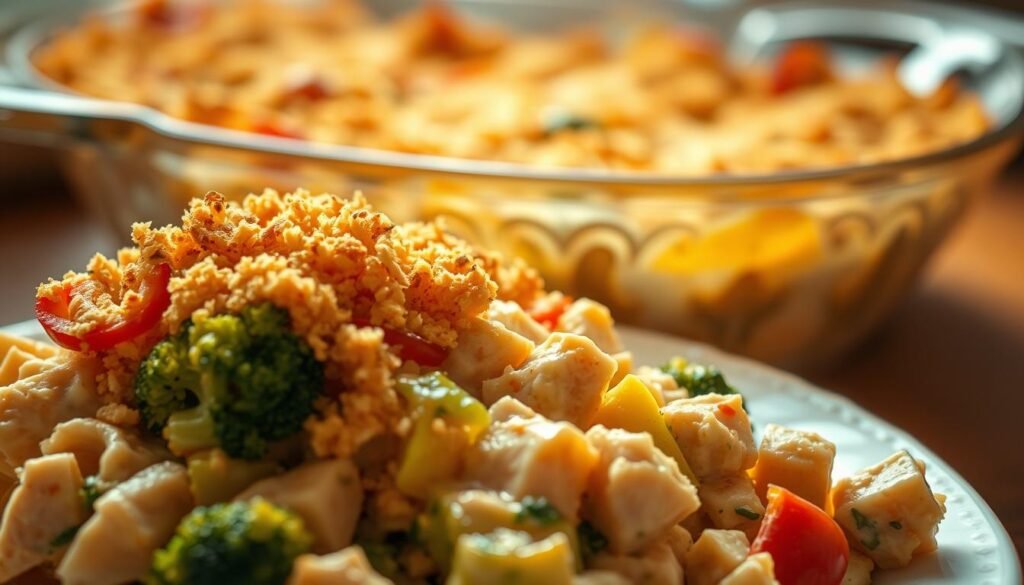
Incorporating Whole Grains
Adding whole grains to Tuna Casserole boosts its nutrition. Whole grain pasta has more fiber than regular pasta. You can also add quinoa or brown rice to make it even healthier.
With these changes, you can enjoy a healthier Tuna Casserole without losing flavor.
Tuna Casserole for Special Diets
Tuna casserole is a favorite dish that can be made for many special diets. It’s great for those with gluten intolerance, dairy allergies, or other dietary needs. You can easily change the traditional recipe to fit these needs.
Gluten-Free Options
For a gluten-free diet, just swap the regular pasta for a gluten-free version. You can use pasta made from rice, quinoa, or corn. This makes the dish safe for those with gluten intolerance.
Also, make sure your canned tuna and soup are gluten-free. Some brands might have gluten in them. You can also make your own cream of mushroom soup using gluten-free flour.
| Gluten-Free Pasta Type | Cooking Time | Pairing Suggestion |
|---|---|---|
| Rice Pasta | 8-10 minutes | Gluten-free cream of mushroom soup |
| Quinoa Pasta | 10-12 minutes | Roasted vegetables |
| Corn Pasta | 7-9 minutes | Dairy-free cheese alternative |
Dairy-Free Modifications
To make a dairy-free tuna casserole, swap out dairy products for alternatives. Use non-dairy milk like almond, soy, or coconut milk instead of regular milk.
Dairy-free cheese alternatives can replace cheddar or mozzarella. Many brands offer dairy-free cheese shreds or slices that melt well.
Also, check the ingredients of your canned soup to make sure it’s dairy-free. Some soups might have dairy or dairy derivatives.
With these simple changes, you can enjoy a tasty tuna casserole that meets your dietary needs. Whether you’re gluten-free, dairy-free, or have another special diet, you can still enjoy this classic dish.
Serving Suggestions
There are many ways to serve Tuna Casserole. Choosing the right sides can make the meal better. It’s all about finding the perfect balance of flavors and textures.
Pairing Tuna Casserole with Salads
A fresh salad can be a great contrast to Tuna Casserole’s rich taste. Try a simple green salad with a light dressing or a grain salad with roasted veggies. The goal is to enhance the dish without overwhelming it.
Here are some salad ideas:
- A classic Caesar salad for a tangy, savory touch
- A quinoa salad with cherry tomatoes and cucumber for a refreshing twist
- A spinach salad with strawberries and feta for a sweet and tangy mix
Delicious Side Dishes to Complement Your Meal
Side dishes can make your meal more interesting. For Tuna Casserole, pick sides that match its creamy, cheesy taste.
| Side Dish | Description | Complementary Element |
|---|---|---|
| Garlic Bread | A classic Italian-inspired bread with garlic and herbs | The savory flavor of garlic goes well with tuna |
| Roasted Asparagus | Tender asparagus roasted with olive oil and seasonings | The bitterness of asparagus balances the casserole’s richness |
| Sautéed Spinach | Quickly cooked with garlic and lemon, spinach adds a burst of nutrients | The brightness of lemon cuts through the creaminess |
By choosing salads and sides carefully, you can make a meal that’s both harmonious and enjoyable. Tuna Casserole is the star, but the right sides can make it even better.
Storing and Reheating Leftovers
To enjoy your Tuna Casserole for longer, learning how to store and reheat leftovers is key. Doing it right keeps your dish safe and tasty.
Best Practices for Storage
First, cool the Tuna Casserole to room temperature within two hours of cooking. This stops bacteria from growing. Then, store it in airtight, shallow containers in the fridge.
Here are some tips for storing leftovers effectively:
- Use airtight containers to prevent moisture and other contaminants from affecting the casserole.
- Label the containers with the date and contents.
- Store in the refrigerator at a temperature of 40°F (4°C) or below.
How to Reheat Without Losing Flavor
Reheating Tuna Casserole right is as important as storing it. To keep its taste and texture, follow these reheating tips:
- Preheat your oven to 350°F (175°C).
- Cover the casserole with aluminum foil to prevent drying out.
- Reheat for about 20-25 minutes, or until the casserole is hot and steaming.
For a quick reheat, the microwave works too. But, the texture might not be as good as oven reheating.
| Reheating Method | Time | Temperature |
|---|---|---|
| Oven | 20-25 minutes | 350°F (175°C) |
| Microwave | 2-3 minutes | High |
By following these guidelines, you can enjoy your Tuna Casserole for days after it’s been cooked. You’ll lose little flavor or texture. Just check the casserole often when reheating to avoid overcooking.
Tuna Casserole Variations to Try
Tuna casserole is a versatile dish that can be enjoyed in many ways. It’s a classic comfort food that can be transformed to suit different tastes and cuisines. This makes it perfect for any occasion.
Mexican-Inspired Tuna Casserole
To add a Mexican twist, try adding spicy ingredients like jalapeños or serrano peppers. Mix in black beans, corn, and diced tomatoes for extra flavor and texture. Use pepper jack cheese instead of cheddar for a richer taste.
Top the casserole with crushed tortilla chips or crispy tortilla strips for a crunchy texture. A sprinkle of cilantro or scallions after baking adds freshness and color.
Asian-Inspired Tuna Dishes
For an Asian twist, add soy sauce, ginger, and garlic to the sauce for a savory flavor. Include shiitake mushrooms or bamboo shoots for an earthy taste and texture. Use sesame oil to sauté the vegetables for an authentic Asian flavor.
Try using udon noodles or rice noodles instead of pasta for a different texture and taste. Top with sesame seeds and chopped green onions for a beautiful finish.
These variations show how tuna casserole can be adapted to explore different cuisines and flavors. It keeps the essence of this beloved comfort food while offering new experiences.
Tuna Casserole in Popular Culture
Tuna casserole is more than just a dish; it’s a symbol in movies and TV shows. It stands for comfort, nostalgia, or the classic American meal.
Featured in Movies and TV Shows
Tuna casserole has made its way into many films and TV shows. It’s often used to show a character’s background or to add a comforting touch. For example, in ‘Breaking Bad,’ a character’s simple yet comforting meal is tuna casserole. This shows its importance in American comfort food culture.
As Renowned food critic, Mark Bittman, once said, “Comfort food isn’t just about filling your belly; it’s about nostalgia and warmth.” Tuna casserole captures this essence, making it a common theme in stories.
Tuna Casserole in American Households
In American homes, tuna casserole is more than a meal; it’s a tradition. It brings families together, often at gatherings or special occasions. Its ease of making and use of common ingredients make it a favorite in many kitchens.
“Tuna casserole is the epitome of comfort food. It’s a dish that warms the heart and fills the belly, a true classic.”
Looking into tuna casserole’s role in popular culture, we see its wide reach. It’s a cultural symbol of warmth, comfort, and the simplicity of American food.
Conclusion: Embracing Tuna Casserole Tradition
Looking back at our tuna casserole journey, I see the happiness in cooking and sharing meals. This classic dish has been loved for years, bringing people together. It’s a favorite for many because it’s easy to make and always a hit.
Sharing the Love
Whether you’re a pro in the kitchen or just starting, keep exploring tuna casserole. Share your dishes with loved ones. This way, you join a community that loves cooking and sharing meals.
Continuing the Cooking Adventure
As you finish this tuna casserole recipe, try new things and mix it up. Every new dish you make improves your skills and adds to tuna casserole’s tradition.
By embracing tuna casserole, you join a tradition that values simplicity, creativity, and community. I’m eager to hear about your adventures and the memories you make with this timeless recipe.

